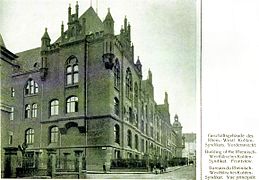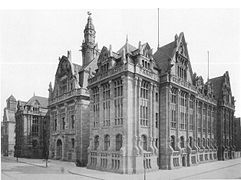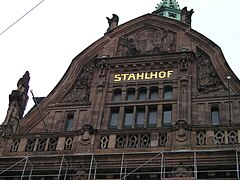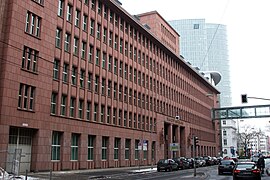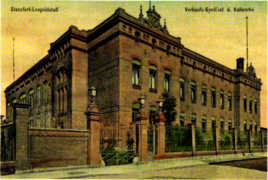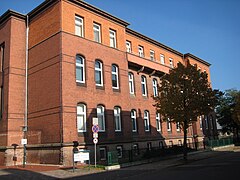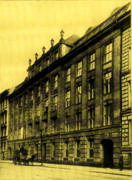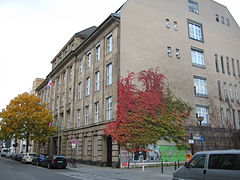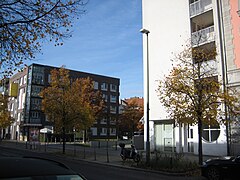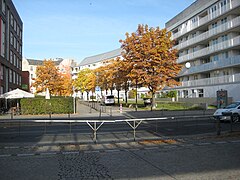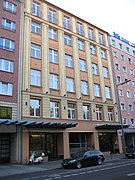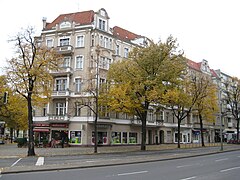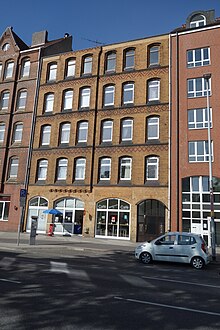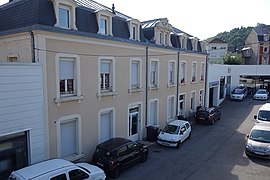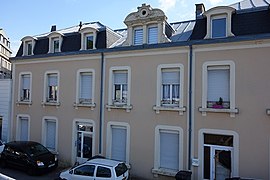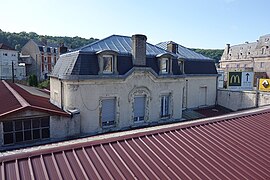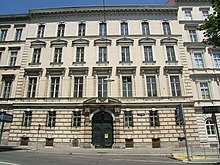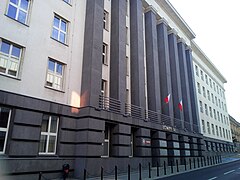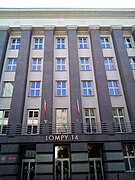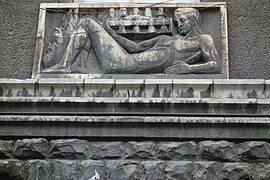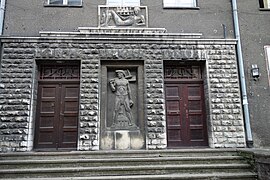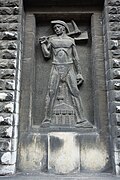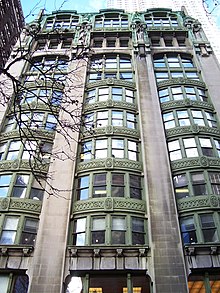Cartel seat (monument)
Cartel seats are the buildings of historical, no longer existing (large) cartels . As a rule, these were so-called syndicates , i.e. cartels with central sales and marketing.
Cartel buildings as cultural remains
In the decades between 1870 and 1945, cartels were widespread as an organizational form of the economy. While loose price cartels (“ breakfast cartels , gentlemen's agreements ”) made no demands on fixed, permanent premises, this was particularly different in the case of the syndicate cartels , the associations with centralized sales points. Hundreds of administrative employees could work in such cartel organizations. The buildings were regularly stately, often representative, richly decorated , for example, with facade decorations. Despite some war losses and demolitions, many of these cartel buildings are still preserved. Most of the time, however, they have become simpler in their appearance because later owners or users did not restore the original decorations (pronounced at: Syndikatshaus in Stassfurt , Bodestr.).
The buildings of historical steering associations and management offices, which are considered to be cartel-like, could also be added to the monument category of large cartel seats. They existed mainly during the Second World War.
Recognition as cultural monuments
Historic cartel buildings can be equated with historic company headquarters , for example of corporations , in terms of monument policy . However, this has not been put into practice: all over the world, a number of buildings are designated and protected as historical company headquarters, but probably not a single previous cartel seat has been signposted as such. If historical cartel buildings are actually listed , they are shown differently and protected for different reasons of memory. Conversely, stately buildings have been demolished in the past without even addressing their economic and historical importance as cartel headquarters.
The cartel theorist H. A. Leonhardt pointed out in 2013 how important certain cartels had been for economic development in the 19th century, such as the syndicate headquarters for coal and steel in the Ruhr area . Because of this, he pleaded for the special "regional economic organization art" of the syndicate cartels to be understood as an intangible cultural asset and to be placed under UNESCO world heritage protection before it is completely forgotten. Suitable places of remembrance for North Rhine-Westphalia are Düsseldorf (steel sales) and Essen (coal sales). Meaningful memorial plaques are to be set up at both locations, at the Düsseldorf steel houses and at the location of the Ruhr coal house, which was demolished in 1997 .
The reasons for the noticeable reluctance of the protection of monuments and the established historical research towards historical cartel buildings can be looked for in the cartel taboo that came into force after the Second World War due to the general ban on cartels . Cartels have been criminalized and positive statements about them are 'unspeakable'. The initiative to consider cartel buildings to be historically memorable has so far only come from critical academic positions or from civil society, for example from the association "Rhein-Neckar-Industriekultur eV", Mannheim, which dedicated an illustrated representation to the local branch of the former Rhenish lignite syndicate.
Occurrences and examples of historical cartel buildings
Belgium
- Brussels : the building of the International Wire Export Company (IWECO) from 1932 to 1939, 54 rue de Namur. Belgium , France , Germany, Czechoslovakia , Hungary and Poland were regular members of this world cartel for wire exports . The United States, Great Britain, Denmark, the Netherlands, and Italy were affiliated to the cartel by individual agreements.
Germany
- The cartel ensemble of the Rheinisch-Westfälische industrial area : Since the end of the 19th century, this region has been the area with the world's most intensive cartelization. Cartels in the coal mining and processing, iron and steel production and processing industries were typical of the region; In addition, there were operational business associations in numerous other branches of the economy such as glass production, pulp production, etc. In the iron and steel industry alone, 13 cartels or cartel bodies had their headquarters in Düsseldorf at the beginning of the 20th century, in Hagen there were even 15, in Cologne 8, in Essen, Siegen, Solingen and Velbert each 2. Evidence of the diverse structures of cooperation in and between cartels could provide a more precise topography of the earlier cartel economy on the Rhine and Ruhr.
- The Berliner Kartell-Ensemble : Berlin was already a popular location for cartel headquarters or sales outlets at the beginning of the 20th century. In the iron and steel industry alone, 9 cartels were located in Berlin at the beginning of the 20th century - and this even though Berlin was not a mining location at all. Since the First World War, more and more cartel functions were exercised across the empire. In Berlin, during the interwar period and the Second World War, real agglomerations of cartel seats emerged, later of steering associations and management offices. These centers were networked with the rest of the Reich and increasingly with the state and politics. The area around the Anhalter Bahnhof was particularly popular because it was easily accessible. Even before the First World War and later, there were numerous sales cartels organized throughout the Reich. A number of important syndicate headquarters (such as the salt industry) were within walking distance from Anhalter Bahnhof. Other cartel quarters existed in the vicinity of the political switching points on Wilhelmstrasse and Friedrichstrasse . Subsequent settlements of steering associations in the late 1930s to early 1940s preferred the bourgeois quarters in western Berlin, such as Charlottenburg and Wilmersdorf .
- The building of the Central German Brown Coal Syndicate in Leipzig , Nordplatz 11, including the interior, has been a listed building since 2007. It was built in traditional architecture between 1921 and 1922 and today serves as the administrative headquarters of the Leipzig Tax Office II.
- The buildings of the Rhenish-Westphalian Coal Syndicate and its successor organizations in Essen. Significance: essential energy supplier for Germany until the 1960s, strategic supplier in Western Europe for coking coal for steel smelting, main energy supplier for the Central and Axis powers in the world wars. There were two buildings: the original syndicate building (1894–1943) and the Ruhrkohlehaus from 1952. The first was bombed in 1943 (except for one side wing), the latter demolished in 1997. Nothing in the streets of Essen is reminiscent of the former “ideal cartel of the world”, an organizational world famous.
- The Stahlhof in Düsseldorf, headquarters of the steelworks association since 1908; Members of this cartel were steelworks in the region and from 1909 nationwide. The building is a listed building because of its architecture and as the “cradle of democracy in North Rhine-Westphalia”, as it was the seat of the British military government after 1945.
- The rolled steel house in Düsseldorf housed the sales point of the Association of German rolled steel companies from 1940. The representative new building, planned years in advance, was apparently also intended to accommodate the three Düsseldorf offices of the international steel cartel (1933–1939). In this merger, the rolled steel grades heavy plate , medium plate and universal iron were assigned to the German syndicate group. In other words, the worldwide export of these types of products was administered and controlled from Düsseldorf. The building is a listed building because of its architecture.
- The building of the German Potash Indicator in Staßfurt, from 1910 in Berlin; Significance: Exercise of a world export monopoly for potash salts up to the First World War, then cartel leadership (together with France) in potash exports up to the Second World War. In Staßfurt, the potash indicator resided in two buildings, on Bodestrasse and Bernburger Strasse. In Berlin, the syndicate complex extended over the three buildings Dessauer Strasse 28–31. The photos below on the right show only half of the building volume, namely the house at Dessauer Straße 28/29.
- The building of five salt industry syndicates in Berlin: Since 1930, the sales organizations for table salt , Epsom salt , chlorine magnesium salt , bromine salt and bromine have been located in Schöneberger Strasse 5 . The building has not existed since around 1990, and has been replaced by a narrow house and a street opening. The size of the vacant lot (approx. 40 m street front) shows the extent of the former premises and the administrative functions.
- The building of the cloth syndicate in Berlin, Anhalter Strasse; Significance: Management of the textile allocation in the steering economy of the Third Reich.
- The building of the pulp sales organization in Berlin, Neue Kantstrasse 32; Significance: Management of the pulp allocation (for paper production ) in the control economy of the Third Reich.
- The building of the Reichsvereinigung Eisen in Berlin-Wilmersdorf, Badensche Strasse 24; destroyed or demolished, new building as a commercial building
- The main Commerzbank building in Düsseldorf , Benrather Strasse 25 (between 1933 and 1945 Hermann-Göring-Strasse ); Here was u. a. also the " International Tube Convention" is located. This was founded in 1926 as a continental European cartel for steel tubes , expanded into an international association in 1929 and re-established in 1935 as the "association ouverte". Members of this cartel were Belgium, France, Germany, Poland, Czechoslovakia, Hungary, the United States and Great Britain.
- The building of the Niedersächsisches Kohlensyndikat GmbH in Hanover , Brühlstrasse 1. This was a distribution cartel for Lower Saxony's hard coal and at the same time a compulsory cartel that was set up on a legal basis in 1919 and existed until 1945.
France
- Longwy / Lorraine : the building of the Comptoir métallurgique de Longwy , 1876–1914, members: crude steel works of French Lorraine. Significance: in the 19th century (up to the First World War) the most famous and best-selling French cartel. Building: converted, without monument protection.
- Paris , rue du Faubourg 164: the first building of the Comptoir Siderurgique de France , occupied for 1919. This association was the French national steel cartel. The Comptoir was a privileged founding member of the International Steel Cartel between 1926 and 1931.
- Paris , rue Paul-Cezanne 1: the second building of the Comptoir Siderurgique de France , occupied for 1938. This association was the French national steel cartel. The Comptoir was a privileged founding member of the newly founded International Steel Cartel from 1933 to 1939.
- Paris : the building in which the newly founded Aluminum Association (AA) resided from 1912. The AA was a European quota and price cartel that did not sell directly, but recorded the aluminum sales of the national groups.
Great Britain
In Great Britain, the capital London was a popular quarter, especially for international cartels. Other locations for cartels were rarer in the UK.
- Birmingham : "The British Locomotive Tube Ass., Birmingham": "The most closed English tube cartel [...]", which was integrated into the international tube cartel via the "Locomotive Tube Agreement".
- London (Westminster): the Steelhouse, Tothill Street. This was the seat of the British Iron & Steel Federation, the British Iron and Steel Corporation Limited and also the British Steelwork Association. While the “Association” and the “Federation” were political organs, the “Corporation” did the practical sales and clearing work.
- London , SW 1: the building of the International Black Sheets Comptoir from 1936, 14 Waterloo Place. In this export cartel, Belgium, France, Germany, Luxembourg, Poland, Czechoslovakia and Great Britain, Denmark, the Netherlands and Italy Poland were regular members. The United States was affiliated to the cartel by individual agreements.
- London : the 11 Ironmonger Lane building, where the International Rail-Makers Association (IRMA) was located. This association was sub-tenant to the auditing firm Pest, Warwick, Mitchell & Co. (Chartered Accountants). The previously existing cartel was re-established in 1926. Members were Belgium, France, Germany, Luxembourg, Poland, Czechoslovakia, Austria, Hungary, Great Britain, the United States and two independent groups of companies.
- London , in the same building at 11 Ironmonger Lane, the International Tin Plate Association had its seat. This association was founded in 1934. Members were France, Germany, Great Britain, the United States, Belgium and Norway. Italy was linked by a special treaty.
Luxembourg
- Luxembourg (City), the COLUMETA SA building (Comptoir luxembourgeois de métallurgie), 1920–1976. Members: steel companies ARBED , Terres Rouges. Common building of both groups and COLUMETA since 1922. Significance: common Luxembourg sales point since the resolution from the customs union with Germany resp. the end of the syndication with German steel companies. The building has been a listed building as the historic headquarters of ARBED since 2013.
Netherlands
- The Hague : the building of the Nederlandsch Cement-Syndicaat (approx. 1900–1970), Bezuidenhoutseweg 1. The association was originally founded in Rotterdam , but later moved its sales office to The Hague.
Austria Vienna)
The Austrian cartel system was clearly shaped by the dominance of the city of Vienna as a cartel location. The historic Viennese cartel ensemble : is characterized by a graduated geographic scope of the ascertainable cartels. The jurisdiction of these associations ranged from the extended urban area (usually craft cartels) to Lower Austria, Crown Land / Republic of Austria, the K&K half of the empire, Austria-Hungary as a whole up to the international, u. & Global Association. Architecturally, the Viennese cartel buildings are not noticeable: they have the same pompous style as the neighboring houses and are not identified by specific industry symbols. Movements of cartel headquarters, especially of small administrations that fit into large apartments, can be detected.
- International
International ferrosilicon company in Vienna with headquarters in Universitätsstr. 11 (until 1930) and (from 1931) at Hegelgasse 13 (both Inner City) (apparently only rented: floor cartel).
- K&K (Austro-Hungarian)
Central defeat of Austrian and Hungarian twine factories, registered cooperative, Maximilianplatz 2, Vienna (later: Freiheitsplatz, Rooseveltplatz 2).
Buying cooperative of the Austro-Hungarian electricity works, Mariannengasse 4 (at that time located in the administration building of the Wiener Stadtwerke-Elektrizitätswerke. Mariannengasse 4–6)
Purchasing, sales and credit cooperative of the Austrian & Hungarian shoe factories, Mariahilferstr. 17 (in 1914 there was also the Photo Atelier Titian, Wien / Vienna, large building with multi-party use)
Central sales office of the united Austro-Hungarian knitting yarn spinning mills GmbH, Lindengasse 41, Vienna
- Austrian K&K part of the empire (with Bohemia and Galicia)
“Cooperative of Austrian Sugar Factory GmbH” (name also known in Czech and Polish), founded in 1896, Elisabethstr. 18. Built in 1862 as Palais Mayr.
- Austrian (Crown Land or Republic)
Main sales point of Austrian cement factories, GmbH: Ditscheinergasse 2 (district: Landstraße)
Cement sales point Ostmark GmbH, Seilerstätte 13, Vienna (Inner City (west of Stadtpark))
Purchasing cooperative of the Association of Electricity Companies, Schleifmühlgasse 4
Purchasing cooperative of the Association of Austrian Local Railways, Schleifmühlgasse 4
Sales office of Austrian gypsum works, Rudolf von Alt-Platz 7, Vienna (Vienna-O)
- Lower Austrian
Lower Austrian Lime Works Sales Cooperative, Plankengasse 6, Vienna (Vienna Inner City)
Sales office of Lower Austrian forest owners, Schauflergasse 6, Vienna (Vienna Inner City)
- Urban Viennese
Purchasing, sales and credit cooperative of the Vereinigte Sohlen- und Riemenlederfabriken in Vienna, Weihburggasse 9 (corner house together with Liliengasse 3, i.e. with two entrances, one each to the intersecting streets).
Central economic cooperative of master shoemakers in Vienna. Kirchengasse 32 (cross street from Mariahilferstrasse).
Central purchasing cooperative of Austrian hairdressers and hairdressing cooperatives in Vienna, Mollardgasse 1. The building has belonged to the Vienna Hairdressing Guild since 1910.
Poland
- Katowice : the building of the "Syndicate of Polish Ironworks" (Syndykat Polskich Hut Żelaznych) in Katowice, Lompy 14. The association commissioned the building in 1926 and moved into it in 1932 after completion. The iron and steel producers of Poland were united in that trade association. The subsidiary organization “Export of Polish Ironworks” (Zwiazelc Eksportowy Polskich Hut Zelaznych) was housed at the same address. This national export cartel was an associated member of the International Steel Cartel between 1927 and 1931 as well as after its re-establishment from 1933 to 1939. After the nationalization of the Polish steel industry in 1945/47, the house fell under the jurisdiction of the Ministry of Metallurgy in Warsaw. In 1947 the socialist "Association of Iron and Steel Metallurgy" was established in the building. After the system change in 1989, the house was still used for industrial purposes. The newly founded, capitalist-oriented “Association of the Polish Steel Industry” (Hutnicza Izba Przemysłowo Handlowa) has been based there since 1991. Polish Steel Association
- Opole , at that time Opole: the building of the "Central sales point of the Silesian Portland cement factories" resp. of the "Association of Silesian Portland Cement Factories" (until 1929), later of the "North German Cement Association GmbH., Verk.-St. Opole, Hippelstr. 10 "(today: Opole, Damrota 10)
Sweden
- Malmö : the INTERCEMENT building, 1937– ?. Members: European cement manufacturers.
Switzerland
Switzerland was a location for both domestic and international cartels.
- Bern : the building of the Swiss Cheese Union , 1914–1999. Members: Swiss cheese traders and producers under the aegis of the Swiss government.
- Geneva : the building of Phoebus SA, Compagnie Industrielle pour le développement de l'Eclairage, 1925–1963, rue de la Rôtisserie 2 et 4, until at least 1942 the seat of an industrial cartel there. Members: the - almost 10 - largest light bulb manufacturers in the world.
- Zurich : the building of the Swiss Aluminum Industrie Aktiengesellschaft (AIAG), in which between 1901 and 1909 the international aluminum cartel called "Aluminum Association (AA)" was housed. The AA was the sales syndicate of the European aluminum manufacturers.
Slovakia
- '' Bratislava '', Palisády 42: the building of the Slovak Cement Syndicate, 1939–1945, known in German as: "Registration office of the Slovak cement factories Pressburg". The Slovak cement works were members of the cartel. The Slovak cement syndicate was a direct member of the German Cement Association from the end of 1940 to the end of 1944, i.e. it was on a par with the five German cement syndicates. Until 1939, the Slovak cement works were organized in the Czechoslovak cement cartel with headquarters in Prague.
Czech Republic
In Czechoslovakia, too, the capital (Prague) was the preferred location for cartel headquarters. Other settlement locations can be identified (e.g. Brno), but were comparatively rare.
- Brno , Jesuitengasse 6 (now: Brno, Jezuitská 4): the building of the “Czechoslovak Cloth Convention” from October 4, 1921. The convention served to standardize the terms of payment and delivery. Almost all important companies in the Czechoslovakian cloth industry belonged to it. Except for the cloth industry i. e. See also plush, Krimmer and piece of felt. The six sub-groups of the cartel were responsible for implementing the conditions. The terms of sale were set independently by each group.
- Prague , Na Poříčí 26: the building of the "Liquor Recycling Company, Ltd.". In that organization were the Czechoslovak resp. Bohemian-Moravian distilleries merged.
- Prague , Opletalova 55, at that time: Lüzowova 55: the building of the Czechoslovak steel syndicate, 192? –1939. The Czechoslovak iron and steel producers were united in that organization. The syndicate was an associated member of the International Steel Cartel between 1927 and 1931 and, after its re-establishment, from 1933 to 1939.
United States of America
- New York City (Lower Manhattan), 75 West Street, the building in which the “Steel Export Association of America” was based from 1926. This association was an export cartel which, according to the "Webb-Pomeree Act" of 1918 , was able to obtain an exemption from the ban on antitrust legislation. The “Steel Export Association” became a “participating member” of the International Steel Cartel in 1938 , which, however, became inoperable in 1939 because of the Second World War. The building they moved into is known as the Old New York Evening Post Building. It was built in 1906-07 for the newspaper of the same name and is decorated in a splendid Art Nouveau style. In 1926 the Evening Post moved into a larger new building.
literature
- Compass Czechoslovakia. Financial yearbook (1937/38). Compass-Verlag, Vienna.
- Compass [Austria]. Financial yearbook (1938 [1937]). Compass-Verlag, Vienna.
- Compass [Austria-Hungary]. Financial yearbook (1913). Compass-Verlag, Vienna.
- Adolph Lehmann: Lehmann's apartment gazette [from Vienna]. Vienna address book. Vienna (1914–1942).
- Holm Arno Leonhardt: Cartel theory and international relations. History of theory studies. Hildesheim 2013.
- Holm Arno Leonhardt: Regional economic organization art. Proposal to supplement NRW's application for UNESCO World Heritage. In: Forum Geschichtskultur Ruhr 2013, pp. 41–42.
- Présidence du conseil (France): Les cartels internationaux. Volume 2. Paris 1956.
Web links
- Rhenish lignite syndicate, Mannheim branch (website of the Rhein-Neckar-Industriekultur eV association)
Individual evidence
- ^ Holm Arno Leonhardt: Regional economic organizational art. Proposal to supplement NRW's application for UNESCO World Heritage, in: Forum Geschichtskultur Ruhr 2013 (2013), pp. 41–42.
- ↑ rhein-neckar-industriekultur.de
- ^ A b Holm Arno Leonhardt: Cartel theory and international relations. History of theory studies. Hildesheim 2013, p. 84.
- ↑ a b Eugen Altmann: On the development and significance of the cartels in the German iron industry. Darmstadt 1909, appendix.
- ^ Berlin address books. Berlin 1799–1943.
- ^ Finanzamt Leipzig II ceremoniously handed over to LE-news-NET from March 21, 2009, accessed on April 6, 2020.
- ↑ Tax offices Leipzig SIB Sachsen, accessed on April 6, 2020.
- ^ Günther Kiersch: International iron and steel cartels. Essen 1954, pp. 70-71.
- ^ Présidence du conseil: Les cartels internationaux. Vol. 2. Paris 1956, p. 35.
- ↑ Comptoir Siderurgique de France: Statutes. Paris 1919, p. 1.
- ^ Présidence du conseil: Les cartels internationaux. Volume 2. Paris 1956, p. 33.
- ^ Wulff, Carl G. (1936): International steel tube cartels as export promoters? Wandsbek: Flotow., P. 41
- ↑ architecture.com
- ↑ Lehmann, Adolph (1859-1942): Lehmanns Wohnungsanzeiger [from Vienna]. Vienna address book. Vienna: Scherl.
- ↑ mein district.at
- ↑ lompy14.pl
- ↑ a b c Présidence du conseil: Les cartels internationaux. Volume 2. Paris 1956, p. 33.
- ↑ hiph.org
- ^ The cement industry in the southeast (1944). [Vienna], p. 23.
- ^ Compass Czechoslovakia. Financial yearbook (1937/38). Vienna: Compass-Verlag (Compass Československo), p. 1196.
- ↑ The economic importance of alcohol production. Spirit Recycling Company, Ltd., Prague, Poříč 26 (1940). In: The New Day (Prague), 02/01/1940.


